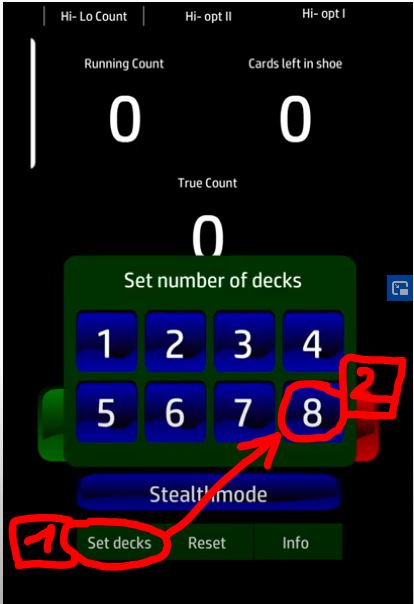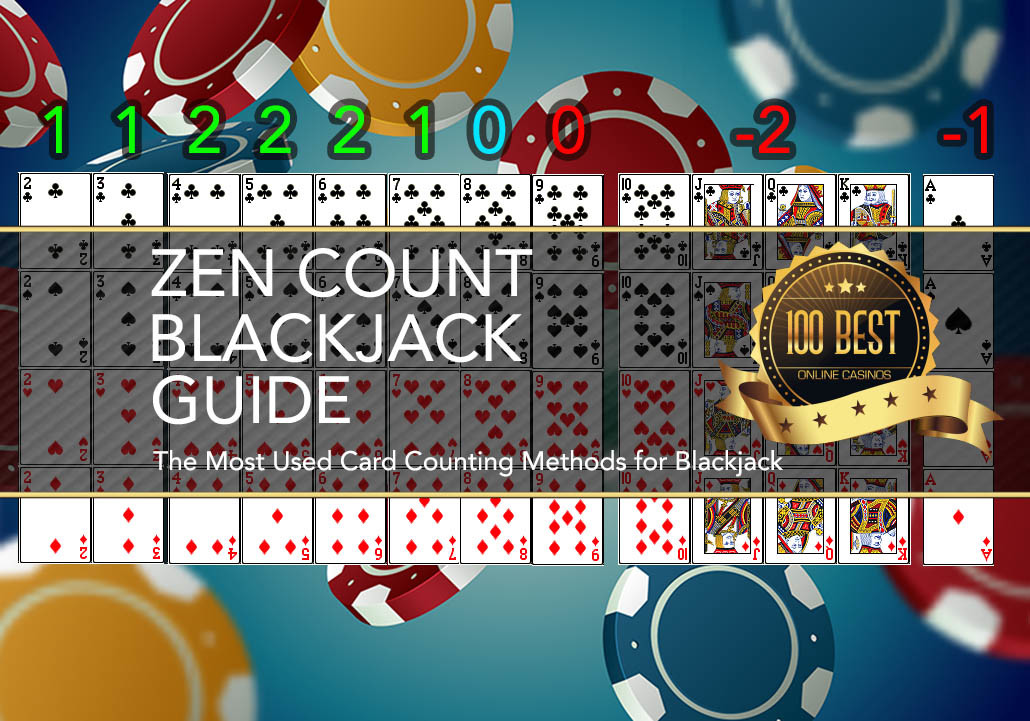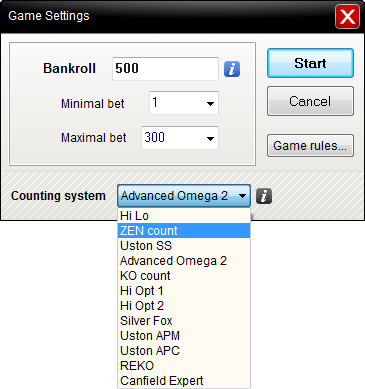Zen Count Blackjack
The Zen Count is a balanced counting system that is similar to Omega II. It’s a Level 2 system aimed at moderately experienced counters. The Zen Count assigns a positive running count to low-value cards and a negative one to high-value cards. The Zen Count takes the middle ground and gives aces a value of -1 and tens -2. Personally, I have tried both and would recommend against a count that requires a side count of aces to a person ready to take up card counting. I chose ZEN because it seems to be a good middle ground between a beginning system and an advanced one. I do not have a copy of 'Blackbelt in Blackjack' anymore so I wanted to make sure I am correctly applying this system: Keep a running count (2,3, and 7 are +1; 4,5, and 6 are +2; 10 and face are -2; ace is -1). Divide running count.
The Zen Count is another great card counting systems that was thought up and created by Arnold Snyder. This is an intermediate system, which makes it more complicated than the more simple Ace-Five and Hi-Lo; as it uses a different technique for card counting. It is not the easiest to learn and use, but Snyder always kept beginners in mind, and created the system in such a way that it could be learned by anyone, with practice.
For those that want to use any blackjack card counting system need to remember that it is necessary to know basic blackjack strategy, and be an expert at it before moving on to more complicated card counting. You can check out our blackjack basic strategy if you need to refresh your memory.
How It Works
Just like the other card counting systems, the Zen Count uses a point system that assigns a value to each card in a regular blackjack deck. The value placed on each card will help the player keep track of and count, which will then help them gain an advantage over the house.
Card: | 2 | 3 | 4 | 5 | 6 | 7 | 8 | 9 | 10 | Jack | Queen | King | Ace |
Value: | +1 | +1 | +2 | +2 | +2 | +1 | 0 | 0 | -2 | -2 | -2 | -2 | -1 |
As you can see, the value each card is given is different than the more simple systems. Most other basic systems exclude the Ace from the count, but the Zen Count includes the Ace, which actually makes counting simpler; no need for players to exclude any card while counting on the fly.
Steps To Using The Zen Count
- At the beginning of each shoe, start with a count of zero.
- As each card is dealt, keep track of each and start your running count.
- After each hand is finished, use the running count to find the true count. The true count is found by dividing the running count by the estimated number of decks still left in the shoe (it is not imperative to be exact, but try to get as close as half a deck).
- Use the true count to determine what decisions should be made the next round.
- Continue tracking the cards dealt, until the shoe is over. Start over after the cards have been reshuffled.

Example Hand
With a fresh shoe and a starting count of zero, playing with a six-deck shoe, 3 players and the dealer. First round of cards are dealt:
You: Ace/5, Player 1: 4/9, Player 2: Jack/7, Player 3: 10/2, Dealer is showing a 3.
The running count would be: -1 +2 +2 +0 -2 +1 -2 +1 +1 = +2. With 6 decks left in the shoe, the true count would be: 2 / 6 = 0.33. After rounding, it would be a true count of +0.
You would need to wait until more cards are dealt to make a better count, but always remember to keep track of each card in order to make a proper running count.
Blackjack Betting
There are certain ways players can send red flags when counting cards, and one important factor is how a player is betting. Seeing as how the Zen Count is more complex, there is a higher degree of risk of being caught. So, it is important to set a betting spread random enough to avoid detection. A good tip for players: bet more after a winning hand, bet less after a losing hand, and bet the same after a push. This is what most non-card counters do, and casino managers know what normal behaviour is.

Example Bet Spread
Zen Count Blackjack Strategy
BET SPREAD | |
True Count | Wager |
+0 or Less | 1 Unit |
+1 | 1 Unit |
+2 | 2 Units |
+3 | 3 Units |
+4 | 4 Units |
+5 or More | 5 Units |

Each player can decide whether to change the number of units they want to bet with each true count. The one advice would be to set a minimum bet, and simply use the units to determine each additional bet from that, up to a maximum amount you are comfortable with.
Player Advantage
True Count | Player Advantage |
| +0 | -1.00% |
| +1 | -0.75% |
| +2 | -0.50% |
| +3 | -0.25% |
| +4 | 0.00% |
| +5 | +0.25% |
| +6 | +0.50% |
| +7 | +0.75% |
| +8 | +1.00% |
The usual edge during any blackjack game is 1.00% in the casinos advantage, however, for every +1 added to the count, the player advantage gains 0.25%. By +4, the player and casino will be even, but as soon as the count reaches +8, the player will have a 1.00% advantage over the casino. This is a very good advantage that any card counter can use in their favor. Even if it is a small percent, like 0.25%, it still means the player is making a steady profit. The Zen Count actually gets higher player edge than Hi-Lo, proving how much more efficient it is.
Zen Count Summary
In essence, the Zen Count is the perfect system for those intermediate card counters, who have already mastered blackjack basic strategy, as well as the basic counting systems. This system is more complex, so players should not take it lightly. Remember, the more complex a system is, the easier the casinos can spot a counter. Make sure to always keep things random, like betting.
By There is no such thing as a “best” Obviously, the answer to this question is not as easy as it appears. Several approaches have been used in the past to evaluate card counting systems. One analytical approach is the calculation of several performance parameters (e.g., playing, betting, and insurance efficiencies). The results are then used to approximate the potential of one system over another. Another approach that is used is to simulate each system against typical game conditions on a high speed computer. Simulations can provide an accurate real-world estimate of the advantages and win-rates that are possible in playing a particular system.
However, the problem with coming up with a ‘best’ card counting system. Instead of a single-level ‘unbalanced’ count you could assign more accurate point values to each card and determine true counts by the exact number of decks or cards remaining. You could improve ‘playing’ efficiency by assigning a ‘zero’ to the Ace and side counting each of them. You could also side count other cards such as 7s, 8s, and 9s thus improving your play against specific hands. You could also incorporate play variations (changes to basic strategy) based on specific counts by remembering ‘every’ index number for ‘every’ play possible. To improve the accuracy of your insurance decisions you could also keep a separate count of all the tens in the deck or shoe. Of course, you don’t want to forget all the ‘practical’ advice each system offers in regard to betting, playing, camouflage, and other tips and tricks of the trade.
Zen Count Blackjack Card Game
I believe the above comment was one of the most important suggestions ever made about card counting. Griffin suggested that it may be better to keep your base count simple to allow your brain the ability to perform other tasks and to utilize other sources of information. These other sources of information can often improve the potential of a single-level count over an advanced 2- or 3-level count that doesn’t use this information. This information includes side counts, shuffle tracking, ace location strategies, key card techniques, and dealer errors. My own experience at card counting has shown that Griffin was probably right.
Zen Count Blackjack App
Human error is another reason to keep it simple. The most advanced card counting system may be one that perfectly balances theoretical power and your human ability to execute it accurately.
ADDITIONAL RESEARCH
Zen Count Blackjack
- The”Best” Card Counting System: A Comparison of the Top 100 by Copyright © 1994 – 2020 All Rights Reserved
FAQ 11: Originally published in Volume 6 Issue 4 of Blackjack Review Magazine
RETURN NEXT FAQ↑1 A single-level count assigns point values in such a manner that the non-zero point values are the same in absolute value, namely +1 or -1. The single-level Hi-Lo count, for example, assigns 2 – 6 as +1, 7 – 9 as 0, and Tens and Aces as -1.